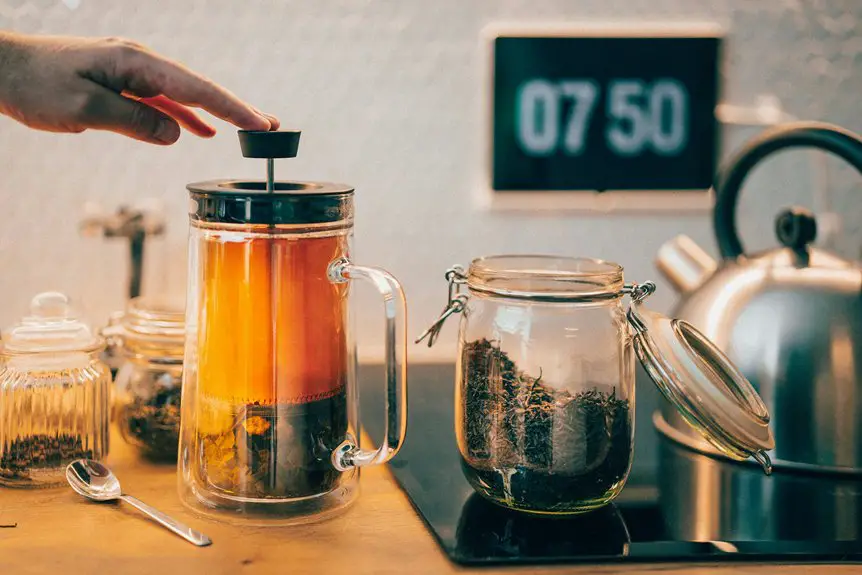When heat pressing on corduroy, start by washing and drying your fabric without softeners to avoid residue. Use a heat press with precise temperature and adjustable pressure, keeping heat low to protect the pile and texture. Press in the wale’s direction using medium pressure to prevent crushing the fabric. Let the garment cool flat to set the design properly. Handle gently to maintain print quality and avoid scorching. Stick around to explore detailed steps and troubleshooting tips for perfect results.
Table of Contents
Key Takeaways
- Pre-wash corduroy without fabric softeners and pre-press to remove moisture and flatten the surface before heat pressing.
- Use a heat press with precise temperature and adjustable pressure controls for even, gentle pressing on the textured fabric.
- Align designs with the wale direction and secure them with heat-resistant tape to prevent shifting during pressing.
- Start with medium pressure and adjust gradually, avoiding excessive heat or pressure to prevent fabric damage or distortion.
- Let the pressed corduroy cool flat for 10-15 minutes before handling to set the design and avoid creases or damage.
Understanding Corduroy Fabric Characteristics
Corduroy’s unique texture comes from its distinct pattern of raised ridges, or wales, which give the fabric both durability and a soft feel.
Corduroy’s raised wales create a durable fabric with a soft, distinctive texture.
When you work with corduroy, you’ll notice these wales vary in width, affecting the fabric’s appearance and flexibility. The denser the wales, the sturdier the fabric, but that also means you’ll need to handle it carefully during heat pressing to avoid crushing the ridges.
Corduroy is typically made from cotton or a cotton blend, which offers breathability but can be sensitive to heat. You’ll want to take into account the pile direction since pressing against it can flatten the texture.
Understanding these features helps you adjust your heat press settings to protect corduroy’s look and feel while ensuring a crisp transfer.
Choosing the Right Heat Press Machine
When choosing a heat press machine for corduroy, you’ll want to take into account the type of machine that suits your needs best.
Look for models with precise temperature control features to protect the fabric’s texture.
Don’t forget to check the pressure adjustment settings to guarantee even, gentle pressing.
Machine Type Options
Selecting the right heat press machine plays an essential role in achieving crisp, lasting designs on corduroy fabric.
You’ll mainly choose between clamshell, swing-away, and draw-style machines. Clamshell presses open like a clam, saving space and offering quick operation—perfect if you’re tight on room.
Swing-away machines let you move the top platen away from the bottom, giving you full access to your fabric; this reduces accidental shifting, which is great for textured corduroy.
Draw-style presses feature a sliding platen that pulls out, providing precise alignment and extra safety.
Consider your workspace, project volume, and ease of use when deciding. Each type handles corduroy differently, so pick one that matches your workflow and comfort level for the best results.
Temperature Control Features
After choosing the machine type that fits your workspace and workflow, you’ll want to focus on temperature control features.
Precise temperature settings are essential when heat pressing on corduroy since this fabric can scorch or become misshapen under excessive heat. Look for a heat press with a digital temperature display that lets you set and monitor the exact heat level.
Consistent heat distribution across the platen is equally important to avoid uneven results. Some machines offer adjustable temperature calibration, so you can fine-tune the heat according to your specific corduroy’s thickness and weave.
Avoid models with only basic or analog temperature controls, as they may lead to inconsistent pressing. By prioritizing accurate and stable temperature control, you’ll protect your fabric and achieve crisp, professional transfers every time.
Pressure Adjustment Settings
Since corduroy has a unique texture and thickness, adjusting the pressure settings on your heat press is vital for a successful transfer. You want enough pressure to guarantee the transfer adheres well without crushing the fabric’s distinctive ridges.
Look for a heat press machine with adjustable pressure knobs or dials that let you fine-tune the force applied. Start with medium pressure and test on a scrap piece of corduroy, increasing or decreasing as needed. Avoid maxing out pressure, which can flatten the pile and damage the fabric.
A machine that offers consistent, even pressure across the platen will help you achieve crisp, vibrant transfers while preserving corduroy’s texture. Choosing the right pressure settings guarantees your finished product looks professional and lasts longer.
Selecting Suitable Heat Transfer Materials for Corduroy
When working with corduroy, you’ll want to choose heat transfer materials that can flexibly conform to its textured surface without damaging the fabric.
Look for thin, stretchable vinyl or polyurethane films that adapt well to corduroy’s ridges and avoid cracking. Avoid rigid or overly thick materials; they won’t adhere properly and may cause uneven pressing.
Consider using printable heat transfer paper designed for textured fabrics, as it offers better flexibility and durability. You should also pick materials with a lower temperature requirement to prevent crushing the pile or causing discoloration.
Preparing Corduroy Fabric Before Heat Pressing
Properly preparing your corduroy fabric is essential for achieving a clean and durable heat press result. Start by washing and drying the fabric to remove any sizing, dirt, or oils that could interfere with adhesion. Avoid fabric softeners, as they may leave residues.
Once dry, iron the corduroy on a low setting to smooth out wrinkles, pressing in the direction of the nap to maintain texture. Next, use a lint roller or brush to clear away loose fibers and dust from the ridges.
Finally, pre-press the fabric for a few seconds using your heat press to eliminate moisture and flatten the surface. Taking these steps guarantees your corduroy is clean, smooth, and ready to accept the heat transfer material effectively.
Setting the Correct Temperature and Time
You need to set the heat press to the ideal temperature to protect your corduroy fabric while ensuring proper adhesion.
Pressing for the optimal duration prevents damage and guarantees a smooth finish.
Let’s explore the best temperature and time settings for your project.
Optimal Heat Settings
Finding the right temperature and time is essential for successful heat pressing on corduroy. Too much heat can damage the fabric, while too little won’t properly transfer your design.
To get the best results, follow these guidelines:
- Set your heat press between 320°F and 350°F (160°C to 177°C) for corduroy.
- Use moderate pressure to avoid crushing the fabric’s distinctive ribs.
- Preheat the fabric for a few seconds to remove moisture and create an even surface.
- Always test on a scrap piece of corduroy first to fine-tune settings without risking your project.
Ideal Pressing Duration
An ideal pressing duration strikes a balance between heat and time to guarantee your design adheres well without damaging the corduroy. Typically, you’ll want to press for 15 to 20 seconds at the recommended temperature, usually around 320°F (160°C).
Press too long, and you risk crushing the fabric’s distinctive ribs or causing scorching. Press too briefly, and the transfer mightn’t fully bond, leading to peeling or fading later. Always follow your transfer material’s instructions, but use a timer to avoid guesswork.
After pressing, let the corduroy cool completely before handling to allow the adhesive to set properly. By controlling your pressing duration carefully, you ascertain a durable, clean finish that preserves corduroy’s texture and appearance perfectly.
Using Protective Layers to Prevent Damage
Although corduroy’s textured surface offers a unique look, it’s also prone to damage from direct heat pressing. To protect your fabric and guarantee a smooth transfer, always use protective layers between the heat press and the corduroy.
Here’s how to do it:
- Place a Teflon sheet or parchment paper over the design area to shield the fabric from direct heat.
- Use a thin cotton or muslin cloth on top of the Teflon sheet for extra protection and even heat distribution.
- Avoid heavy materials that could flatten the texture; lightweight layers work best.
- Check the protective layers frequently for wear and replace them as needed to maintain consistent results.
Following these steps helps prevent scorching, crushing, or unwanted imprints on your corduroy.
Positioning Your Design on Corduroy
Two key factors determine the success of your heat press on corduroy: accurate design placement and fabric alignment. First, lay your corduroy flat, smoothing out any wrinkles along the wale (the vertical ribs). Align your design so it follows the wale’s direction for a clean, professional look. Use heat-resistant tape to secure your design, preventing shifts during pressing.
| Step | Tip | Reason |
|---|---|---|
| Lay fabric flat | Smooth wrinkles | Prevents uneven pressing |
| Align design | Follow wale direction | Maintains fabric texture |
| Secure design | Use heat-resistant tape | Stops design from moving |
| Double-check | Confirm placement visually | Guarantees accuracy before heat |
Positioning your design carefully sets the foundation for a flawless heat press result on corduroy.
Applying Pressure Appropriately
When you apply pressure during heat pressing on corduroy, you need to balance firmness with care to avoid crushing the fabric’s distinctive ribs.
Too much pressure flattens the texture, while too little won’t transfer the design properly. Here’s how to get it right:
- Start with medium pressure to test how the fabric responds.
- Adjust pressure incrementally, increasing only if the transfer isn’t clear.
- Use a heat press with adjustable pressure settings for precision.
- Avoid pressing too long under high pressure to prevent fabric damage.
Cooling and Handling After Heat Pressing
After heat pressing your corduroy, you’ll want to let it cool properly to set the design without causing damage.
Handle the fabric gently to avoid stretching or distorting the texture.
Following these steps helps maintain the crisp look and feel you’re aiming for.
Optimal Cooling Time
Cooling corduroy immediately following heat pressing plays an essential role in preserving the fabric’s texture and guaranteeing the design sets properly.
To optimize cooling time, you want to avoid rushing or leaving the fabric exposed too long before handling. Here’s how to get it right:
- Let the fabric cool flat for at least 10-15 minutes to solidify the heat transfer.
- Avoid stacking or folding corduroy while still warm to prevent creasing.
- Use a clean, flat surface away from direct sunlight or drafts for consistent cooling.
- Check the design’s firmness before moving or wearing the garment to guarantee it has properly set.
Following these steps helps maintain corduroy’s unique texture and guarantees your design stays vibrant and durable.
Safe Handling Techniques
Although heat pressing sets your design, you’ll need to handle the corduroy carefully while it cools to protect both the fabric and the print.
Resist the urge to move or fold the fabric immediately; allow it to rest flat on a heat-resistant surface. Use clean, dry hands to avoid transferring oils or moisture that could affect the print’s adhesion.
If you need to reposition the fabric, do so gently to prevent disturbing the design. Avoid stacking heavy objects on the corduroy until it’s completely cooled to maintain the print’s integrity.
Keeping the fabric undisturbed during this phase guarantees your design stays vibrant and intact, giving you the best finish on your heat-pressed corduroy garment.
Preventing Fabric Distortion
When you let corduroy cool too quickly or handle it roughly, the fabric can stretch or warp, ruining your design.
To prevent fabric distortion after heat pressing, follow these steps carefully:
- Allow the fabric to cool naturally on a flat, heat-resistant surface to maintain its shape.
- Avoid moving or folding the corduroy immediately after pressing; give it enough time to set.
- Use a protective sheet, like parchment paper, between the heat press and fabric to prevent direct heat damage.
- Handle the fabric gently, avoiding any pulling or stretching while it’s still warm.
Troubleshooting Common Issues With Corduroy Heat Pressing
If you encounter uneven prints or fabric damage during heat pressing on corduroy, it’s often due to incorrect temperature, pressure, or pressing time.
First, double-check your heat press settings—too hot or too much pressure can crush the pile and distort the fabric. If your print looks faded or incomplete, try increasing the temperature slightly or extending the pressing time, but do so gradually.
On the other hand, if you see scorch marks or fabric shrinkage, lower the heat and reduce pressing duration.
Uneven prints might also result from improper placement or insufficient pressure; verify the fabric is flat and the press applies even pressure across the surface.
Always test on a scrap piece before pressing your final item to avoid costly mistakes.
Frequently Asked Questions
Can Corduroy Be Heat Pressed With Sublimation Prints?
You can heat press sublimation prints on corduroy, but be cautious. Corduroy’s texture might affect print quality, so use a protective sheet and lower temperature to avoid crushing the pile or distorting the design during pressing.
How Does Corduroy Color Affect Heat Transfer Results?
You’ll notice darker corduroy can make colors look more muted after heat transfer, while lighter shades show vibrant prints better. Always test first since fabric color directly impacts your transfer’s brightness and clarity.
Are There Specific Brands of Heat Transfer Vinyl for Corduroy?
You’ll find that brands like Siser and Cricut offer heat transfer vinyl designed for textured fabrics like corduroy. They provide flexibility and strong adhesion, helping your designs stick well without damaging the fabric’s texture.
Can Heat Pressing Damage Corduroy’S Texture Permanently?
You’d think heat pressing could turn corduroy into a flat pancake forever, right? Luckily, if you control temperature and timing, you won’t damage the texture permanently. Just avoid excessive heat or pressure to keep those ridges intact.
Is Pre-Washing Corduroy Necessary Before Heat Pressing?
You don’t have to pre-wash corduroy before heat pressing, but it’s a good idea. Pre-washing removes sizing and prevents shrinking, helping your design adhere better and keeping the fabric’s texture intact for a cleaner finish.
- Does Chiffon Fabric Stink - July 15, 2025
- Does Chiffon Fabric Affect the Economy - July 15, 2025
- Does Cotton Fabric Have a Nap - July 15, 2025







